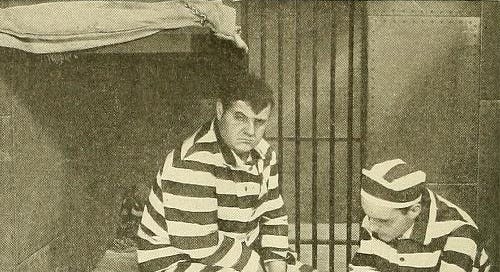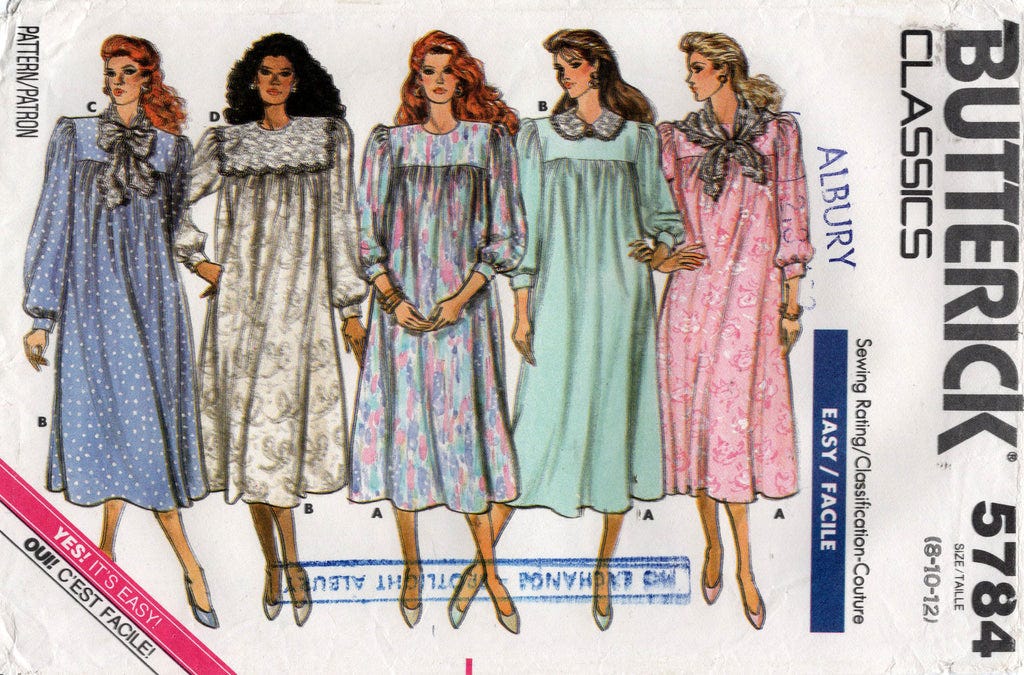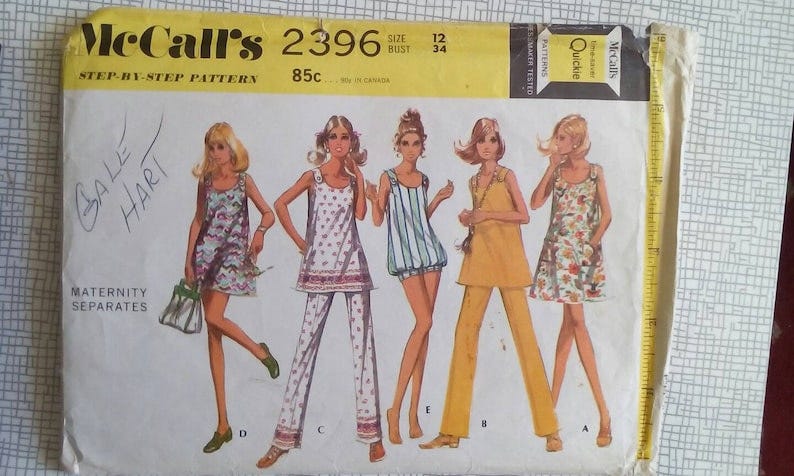Overall, maternity clothes are trash. It’s as though clothing manufacturers had their design team kinda guesstimate what shape a pregnant woman might be at some point during her pregnancy and cut their patterns to match their imagination.
I picture the scene going something like this:
Overworked clothing designer holding up striped, tent-shaped article of clothing that is neither a shirt nor a dress: But boss, do you think we should measure an actual pregnant woman before we send this pattern to the factory floor?
Maternity clothes magnate: (chomping cigar, with a fake mid-atlantic movie accent for some reason) No time for such trifling details! They’ll wear what we sell or they’ll wear burlap sacks!
I learned recently (too recently) that most of the models used to display maternity clothes aren’t even pregnant. They’re models wearing pads on their bellies and sometimes their breasts, as though those are the only places where extra weight sits during pregnancy. What does seeing a model perhaps too thin to menstruate wearing an ill-fitting smock cut to fit Humpty Dumpty do to give me a sense of how it might look on a real human body? Is any care given whatsoever to how the clothes wear?
Like a lot of first-time moms, with my last pregnancy, I had no idea what I was doing and ended up buying a lot of shit that I didn’t need. That included maternity clothes. I packed them carefully away after Juniper was born, positive that if I were to have another baby, I would be grateful to have such essentials as a floor-length leopard-print dress, cutoff jean shorts with a panel that is pulled up and over the belly so that said shorts don’t fall down, and three identical ASOS tops that ride up uncomfortably at the sides if you try to walk while wearing them.
It didn’t occur to me, apparently, that I might be huge during a different time of year. LA’s “winter” doesn’t involve snow, but life in Southern California has turned me into a wimp, and I don’t consider it shorts or maxi dress season until the temperatures are at least in the upper 80’s— and that doesn’t happen until June around here. Some of the clothes didn’t really work at all— they fit wrong, they wore out immediately, they rode up or fell down.
At least my first round maternity clothes were cheap.
Expensive maternity clothes are for women who are wealthy enough to not know or care how much anything costs. These were the people unfazed by the cost of produce at Erewhon, haphazardly throwing $12 wedges of cheese into their shopping baskets, women who don’t personally drink “complex” rosé but always have a few bottles on hand just in case they get invited to a summer day party. You know, women who pay somebody else to worry about all that. Women with finance husbands and expired La Mer in their guest bathrooms. Women who don’t work outside the home but have full-time nannies. Good for them.
I thought that maybe my issue is that I’d find better quality clothing at a higher price point. But it’s hard to justify a high price point on clothing worn only worn for four, maybe five months at a time, probably only once or twice over the course of a person’s life.
Have we ever gotten pregnant fashion right?
In the 1980’s, pregnant women dressed like frilly little Easter eggs— girlish pastels, collars that splayed out from the neck like adult bibs, bows at the neck. There are pictures of my pregnant mother and aunts from the decade in which they’re wearing maternity clothes that look nothing like the style of clothing they normally wore.
There are attempts at 80’s maternity power suits out there, but overall, maternity clothes designs of this era overcompensate for the inherently sexual nature of pregnancy— at the time, IVF and IUI weren’t common medical practices and so the overwhelmingly most popular way to get knocked up was through old fashioned unprotected sex. The bashful girlishness of these Butterick patterns project an eyelash-batting Who Me? Raw dog? over the corporeal evidence of the expecting mother’s sexuality.
Even Princess Diana wasn’t spared the ruffled maternity menace; when she was pregnant with Prince William, she dressed like a posh Cabbage Patch Kid.
Things were slightly better in the 1970’s. I’d wear most of this stuff from this McCall’s pattern, for example:
I’m not in love with all of the fabric choices here, but it’s a pattern which means you can use whatever fabric suits one’s fancy. If I were a groovy 1970’s lady with the spare time to sew my own clothes while I waited for my husband to return home from from the union job at which he earned enough income to comfortably support a family of 4 on a single income, I’d wear this stuff.
This pregnancy, rather than buying a rotation of cheap clothes that I’ll no longer need after June, I’m renting all my clothes from apps. The clothing rental apps’ maternity selection is higher-end than what I’d be comfortable purchasing for such a short life in my closet, from companies that traffic in brand with names along the lines of “The Eggshell,” “abundance.” and “Sloane & Silas” or like “Penelope & Jasper.” The good news is that “nice” maternity clothes are marginally better than the fast fashion slap jobs I’d relied on before, but they’re still pretty bad compared to regular clothes.
I rented a pair of jeans recently that had a near-perfect rating from other users on the app. The jeans do not stay up. I am constantly hitching up my pants over my round midsection. They slowly slither floorward, taking my underwear with them. I feel like I need suspenders to wear them, which would give give me a real mayor of the munchkin city look. And this is a good pair of pregnancy jeans. I am not abnormally large right now, nor am I carrying a large baby. The pants just fit my human body oddly.
Jumpsuits and rompers are a slightly better choice as they save me from the indignity of trying to force a waistband— a feature designed to hug concavity— around a body that is defiantly convex. But jumpsuits and rompers mean getting nearly totally disrobed every time I need to use the bathroom, which is often.
Overalls are a fine happy medium— but I feel like a preschooler in them.
The most reliably comfortable maternity outfits are the ones that make me look a little bit like my own personal riff on The Hamburgler— a striped, form-fitting top, stretchy black leggings with a high waistband (they need to be black because pulling pants up over a large belly can and will cause camel toe, and black is the best color to disguise this). Maternity clothing brands love a striped top. They love a checkered top. I’d love to no longer look like a member of the Happy Meal Gang that just ate all of the McNugget Buddies.
It’s fitting, in a way, that so many clothing designed for pregnant bodies are evocative of being a cartoon who escaped from prison.
Yes, this time is fleeting, one day I will look back on it nostalgically, ok, sure, fine. But I will not miss the clothes.






You're reminding me of the flowery dungarees I bought at a National Childbirth Trust sale and which I lived in for the last couple of months of my pregnancy. Somewhere in the UK Lib Dem campaign archives will be a picture of me wearing said dungarees on an election leaflet. Sadly I didn't get to sign off the quote attributed to me about the closure of a maternity unit, which began "As an expectant mother..." This was, of course, written by a man.
But, yes, maternity clothes are a nightmare. I really like the new trend of renting and recycling them, though, so that you have more chance of actually finding something that fits your unique shape at an affordable cost.